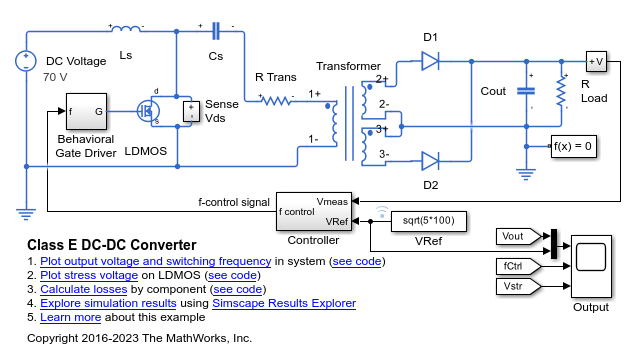ee_getEfficiency
Calculate efficiency as function of dissipated power losses
Syntax
Description
efficiency = ee_getEfficiency('loadIdentifier',node)
Before you call this function, you must have the simulation log variable in your
current workspace. Create the simulation log variable by simulating the model with
data logging turned on, or load a previously saved variable from a file. If
node is the name of the simulation log variable, then the
table contains the data for all semiconductor blocks in the model. If
node is the name of a node in the simulation data tree,
then the table contains the data only for the blocks within that node.
Checking efficiency allows you to determine if circuit components are operating
within their requirements. All blocks in the Semiconductor Devices library, as well
as some other blocks, have an internal variable called
power_dissipated, which represents the instantaneous power
dissipated by the block. This instantaneous dissipated power includes only the real
power (not the reactive or apparent power) that the block dissipates. When you log
simulation data, the time-value series for this variable represents the power
dissipated by the block over time. You can view and plot this data using the
Simscape Results Explorer. The ee_getPowerLossTimeSeries function also allows you to access this
data.
Note
The power_dissipated internal variable does not report
dynamic losses incurred from semiconductor switching or magnetic
hysteresis.
Three different variables, lastTurnOnLoss,
lastTurnOffLoss, and
lastReverseRecoveryLoss report the switching
losses.
Switching losses are losses associated with the transition of the semiconductor switch from its on-state to its off-state and viceversa, and also with the energy dissipated during a reverse recovery event. They are frequency dependent.
The ee_getEfficiency function calculates the efficiency of
the circuit based on the losses for blocks that have a
power_dissipated variable and that you identify as a load
block. The equation for efficiency is
where:
Eff is the efficiency of the circuit.
Pload is the output power, that is, the power dissipated by load blocks.
Ploss is the power dissipated by nonload blocks.
This equation assumes that all loss mechanisms are captured by blocks containing
at least one power_dissipated variable. If the model contains any
lossy blocks that do not have this variable, the efficiency calculation gives
incorrect results.
Some blocks have more than one power_dissipated variable,
depending on their configuration. For example, the N-Channel MOSFET
block has separate power_dissipated logging nodes for the MOSFET,
the gate resistor, and for the source and drain resistors if they have nonzero
resistance values. The function sums all these losses to provide the total power
loss for the block, averaged over simulation time. The function uses the loss data
to calculate the efficiency of the circuit.
efficiency = ee_getEfficiency('loadIdentifier',node,...
startTime,endTime)power_dissipated
data extracted from a Simscape logging node within a time interval. startTime
and endTime represent the start and end of the time interval
for calculating the efficiency. If you omit these two input arguments, the function
calculates the efficiency over the whole simulation time.
[
returns the efficiency of a circuit and the power loss contributions of the nonload
blocks in a circuit based on the data extracted from a Simscape logging node.efficiency,lossesTable]
= ee_getEfficiency('loadIdentifier',node)
Examples
Input Arguments
Output Arguments
Assumptions
The output power equals the total power dissipated by blocks that you identify as load blocks.
The input power equals the output power plus the total power dissipated by blocks that you do not identify as load blocks.
Version History
Introduced in R2017a


